Frieze art fair: How the rich collector dresses
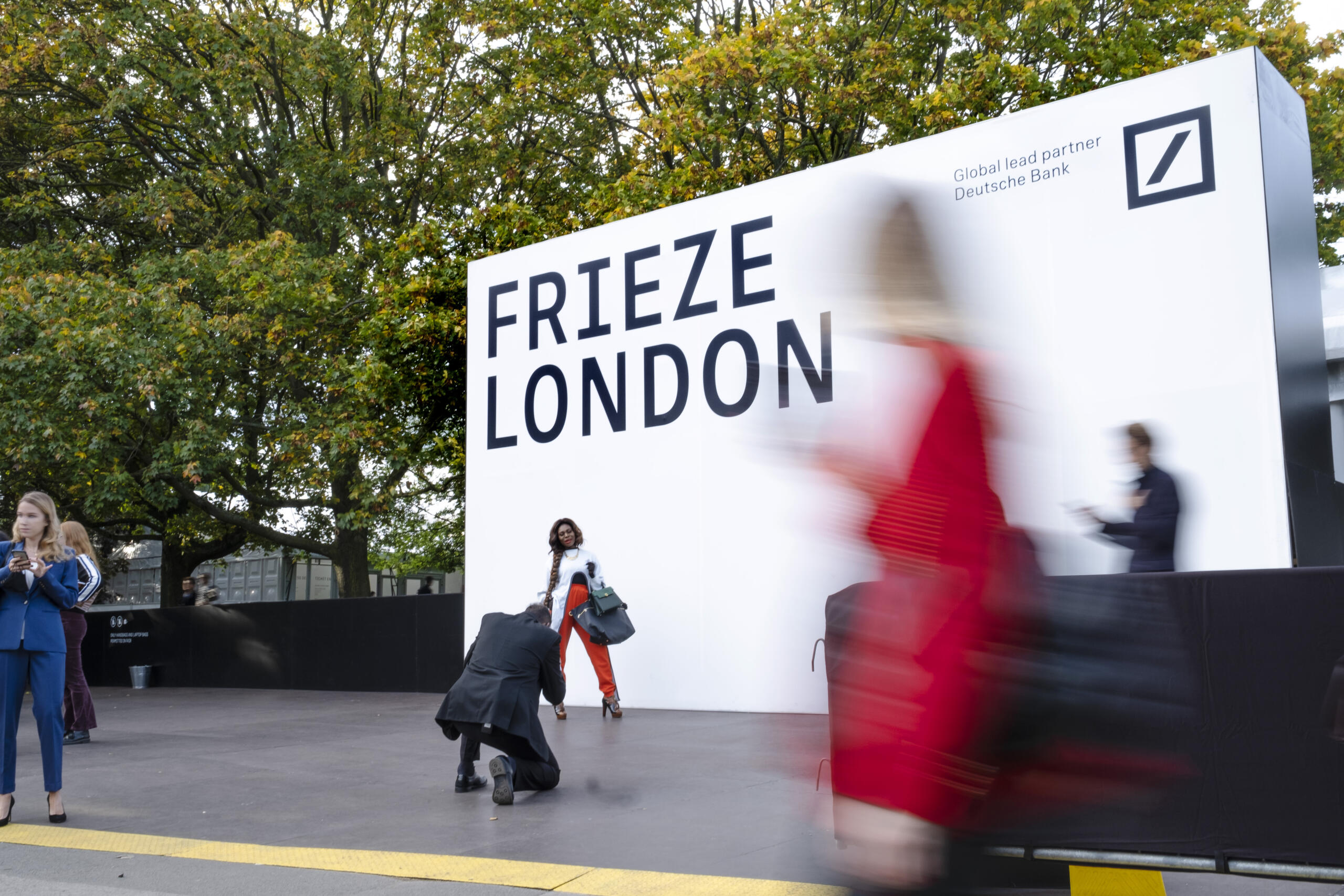
Frieze, the contemporary art fair in London, makes for great people watching. The art world brings in such a broad spectrum of types, of tribes. Although from a clothing point of view there always seems to be one consistent theme, which is a specific mix of lots of money, and dressing up.
In fact, you can spot people going to Frieze around Baker Street station not because they're wearing a particular style (it could be tailoring, fashion, streetwear) but because they're so clearly making an effort.
Perhaps it’s connected to the money. The clothes often look new, shiny, unwrinkled. But there is also a sense that people know they’re going to be on show, and so are dressing up for the occasion.
The interesting question then is, what does ‘dressed up’ mean to this particular international rich set?
Sometimes it means going full bore on a particular genre. A tall man sat down next to us at lunch wearing an actual 10-gallon hat, complete with leather jacket and leather trousers. Of course, he also didn't take the hat off when he arrived, which was predictably impractical in a crowded restaurant.
Walking around, your eye will often be caught by someone in a full-on heavy-metal look: black faded T-shirt, black jeans, black boots, perhaps studs somewhere around the place. Or a full-on Canadian tuxedo: denim jacket and jeans, with a bolo tie. These are often well executed, but at the same time it’s hard to feel there’s much individuality, given they’re such set looks.
You can understand the temptation though when you see what other men fall into without clear direction. It’s that familiar menswear problem: suits and ties are out, you can’t just wear a T-shirt and jeans, so what do you wear?
The worst is a suit and sneakers. Not because it can never work, but because the execution is often poor. Trainers with tailoring is not my style, but I can see it can be done better or worse. Most obviously, you need enough clearance between trouser and trainer that they never touch or, the other extreme, a wide trouser that puddles all over on the shoe.
Either can be its own, consistent style, but few men were doing that. More common was skinny jeans, chunky trainers and some kind of ill-fitting jacket substitute, like a chore. It’s not the three pieces of clothing together that’s the problem - it’s the fact there’s little understanding of how they should work together, particularly around fit and proportion.
It’s glaringly obvious this can be done better, because the women are everywhere doing it better - and often in boyish combinations.
If you wanted to see how a tweed-jacket-and-jeans could be done well, you only had to look at the women. If you wanted to see a velvet jacket worn in a modern and informal way, again there were plenty of examples.
One table at the wonderful Maison Francois, where we had lunch, was taken by a group of seven women, all of whom I would have taken style points from. One in an oversized shirt, jeans and boots; another in navy blazer with pegged chinos; another in a tonal combination punctuated by bright-yellow heels.
As ever with women’s clothing, the key is not to lift any of this wholesale, but to learn little things here and there - how proportions compliment and contrast, or how similar colours are broken up with a scarf, a belt.
This lady below was wearing a loose but flattering indigo-dyed linen suit, with a black blazer worn over the top. And wonderful old leather sandals.
One more negative, before I move onto outfits we liked: the male tendency to focus on an item rather than an outfit.
We see this in classic menswear with shoes, but in this world, with no limits of money or (almost) propriety, it’s more the top layer. A middle-aged man will wear an Issey Miyake pleated jacket, but pair it with a bog-standard T-shirt and jeans. The same with a silk pjyama shirt, or a black leather jacket, or a streetwear denim jacket with shouting written all over it.
I can see the appeal of each, but the thought process just seems to stop there. As if you’ve bought the shiny thing the salesman was showing you and thought that was it - you never have to think about clothing again.
OK, no more negativity. I did find this a little depressing, but also interesting sociologically - how common these menswear issues are across society. And there were also some nice looks around - ones that had both clear personality and were well-executed.
They often weren’t my style, but if you find clothes interesting, that shouldn’t be a limitation.
Take the two chaps above, for example. On the left is an effective mix of brown and black, shiny and matte, with balanced fits: longer length on the jeans suits the looser, larger jacket; the colour palette suits him; the headphones are a nice touch.
I don’t think anyone reading would wear the coat on the right, but it fits the look, and the colour of the trainers is a nice match to the muddy/country palette elsewhere - almost like a trainer version of a lug-soled boat shoe.
Here, the russet corduroy suit and green tie of the gentleman in the middle are lovely together. The guy on the left is a good example of jacket/trousers/trainers not really working.
Orange waistcoat, beige cords, carpet slippers, and a looped green-stripe scarf. Pleasingly old-school artist, and nicely done. Behind him, another navy suit with chunky trainers that isn’t working.
Clean, simple, individual. Nothing extraordinary but a cut above many others by just executing those things.
A woman thrown in for the colour combination. Looks like this always made me look twice, to see exactly what the different shades were. And pick up on the tabis.
A nicely done workwear look - all in pieces that look perfectly worn in and therefore personal. Such a range of types and tribes.
It was nice seeing a sprinkle of older Spanish men in Tebas, and examples of traditional Bavarian or Austrian jackets - generally better executed than the other tailored-jacket-substitutes around. It helps if everyone you know has always worn one.
If you’re going to do relaxed tailoring, do it with a neat cardigan and a suede shoe. If you’re going to do a very loose tee and trousers, have the physique for it. Both of these guys know what suits them.
A full-bore suit style, but with more personality than most and well executed.
Something about the colour combination was very pleasing here. Helps that the fits are all quite clean.
Just loved the matching trainers.
Although there were many exceptions, this Guardian article gets it right about how the art felt. The clothes were more interesting.


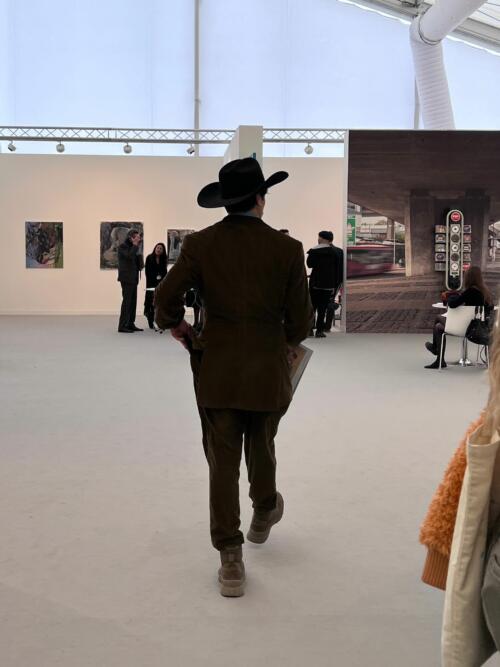
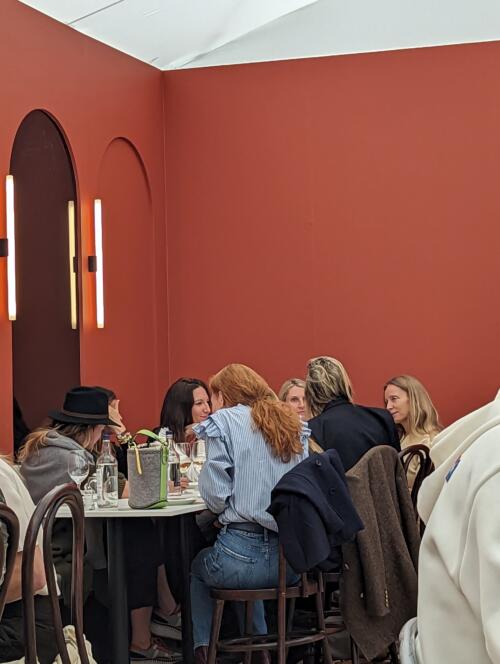
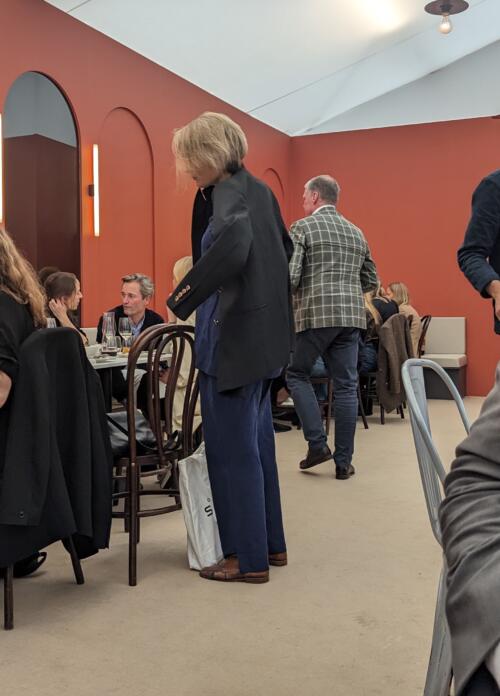
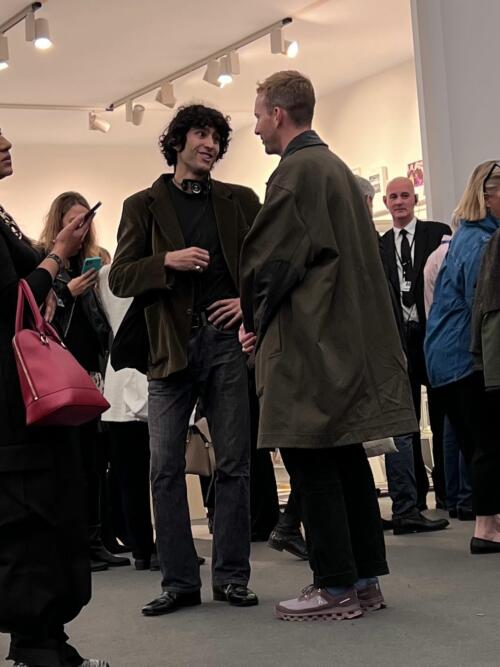
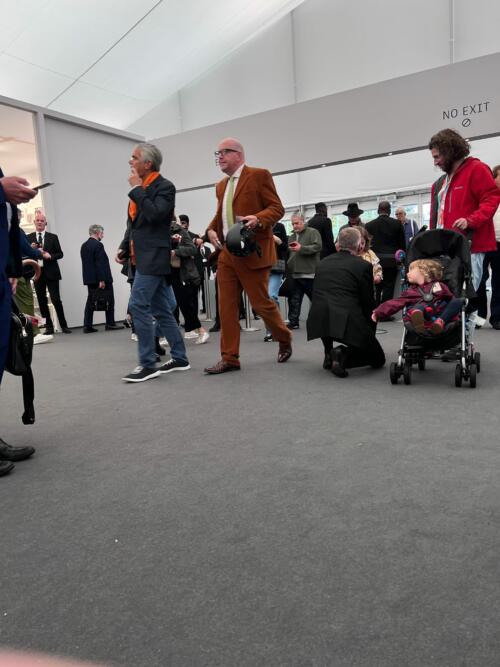
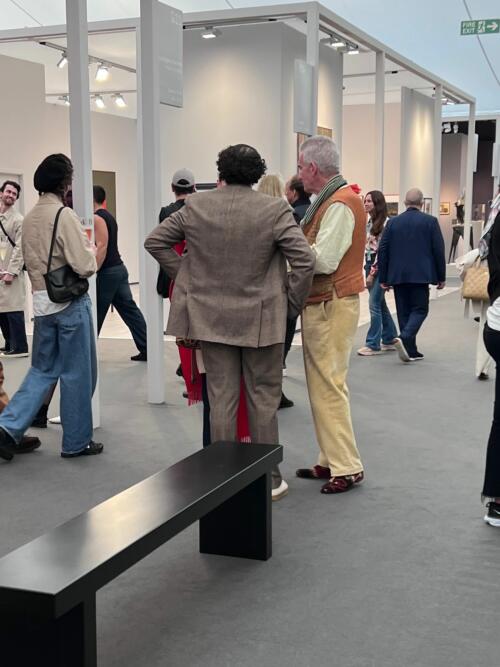
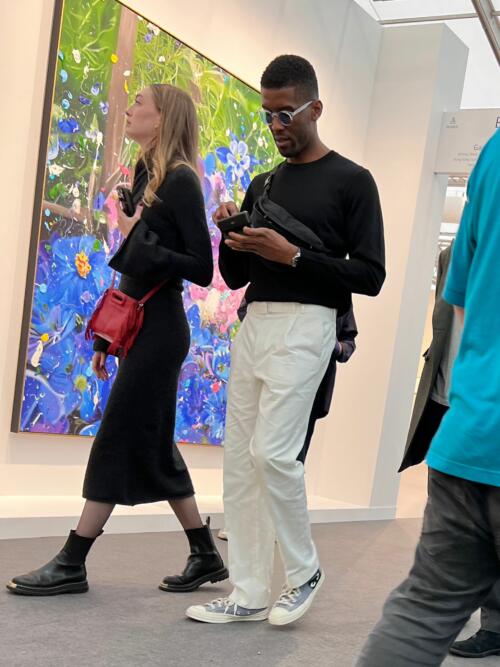
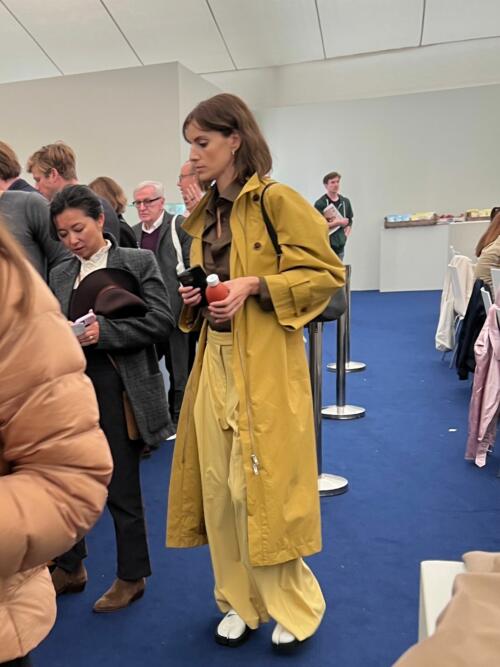
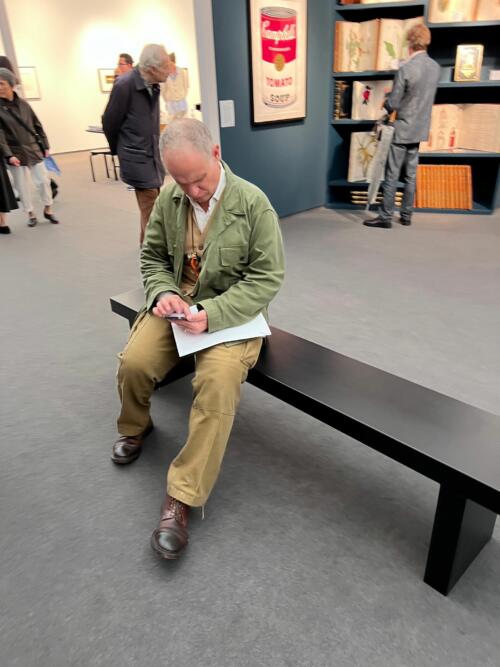
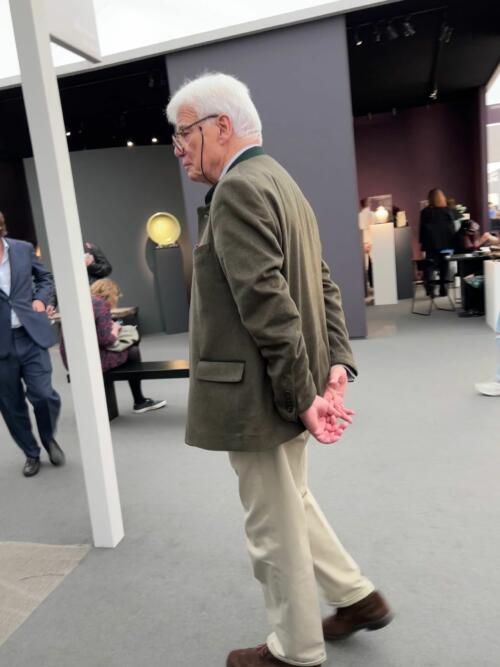
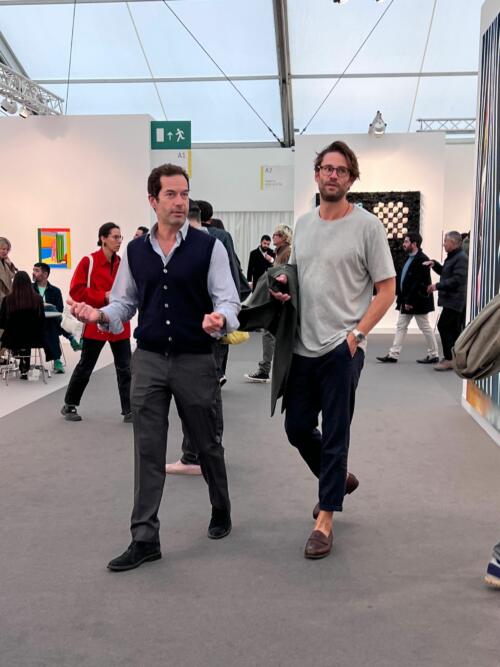
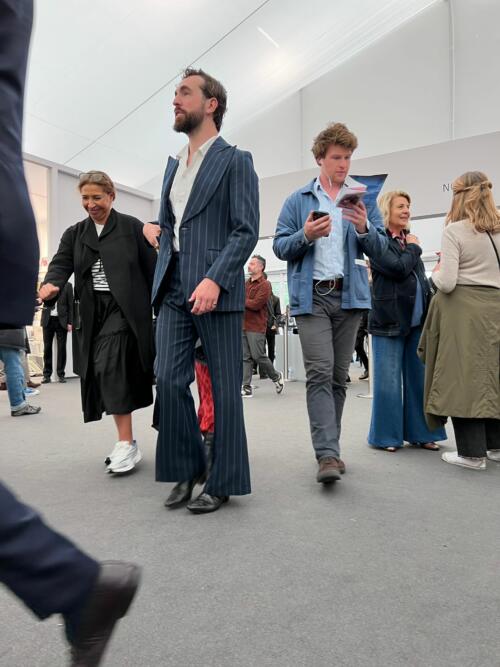
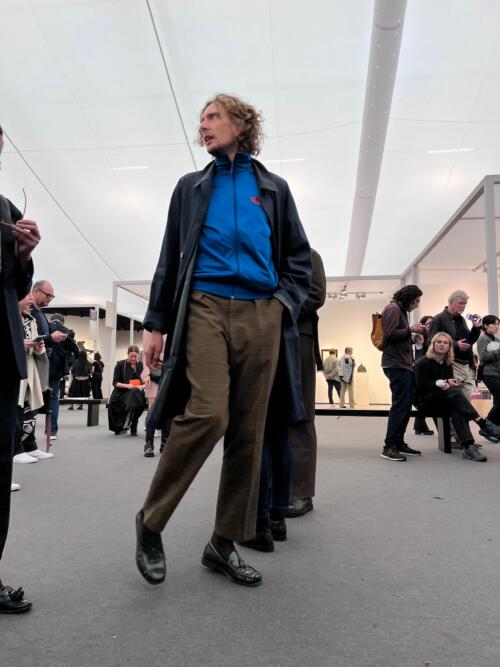
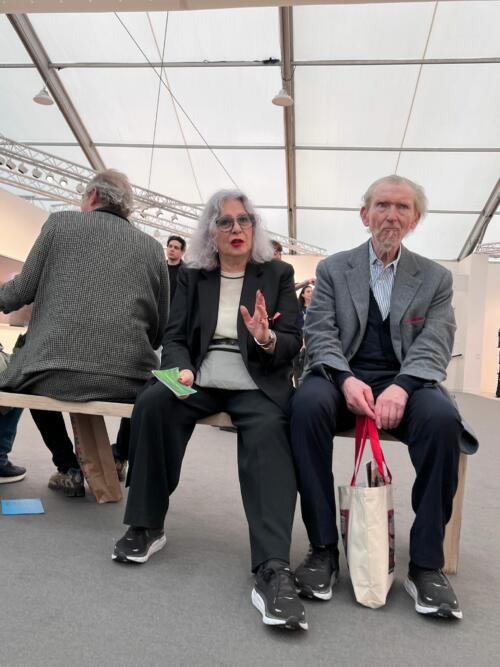


























Simon I think you are missing a couple of key things here.
A lot of the men you’ve photographed here simply couldn’t give a toss about what they are wearing because their heads are full of so much other stuff, and stuff which probably means more to them than a carefully selected outfit.
Equally, a lot of them will have chosen particular outfits because they combine to create a look which they feel expresses their personality.
When you move in a particular world, as people who live in the contemporary art space do, you don’t see conforming to a “norm”, which is what you are trying to demonstrate here, as being something of importance.
The fact that the women you describe seem to have made more of an “effort” is not really a surprise though, as typically, no matter what, the context they think about it more than men do.
By the way, I thought Frieze was outstanding.
Thanks.
With many people, certainly, they couldn’t care less, but what I found most interesting was the people that clearly did make an effort, who really did care, as I mentioned.
And on the personality point too – with those dressed in particular genres, the point was there wasn’t much personality, just copying a look. And lots of looks I did like, again as mentioned, that weren’t my style.
A somewhat strange article. I’m not sure about the blurry, secretly taken photos. Looks rather amateur.
I agree with some of the points raise by Alice. I guess this article should be read as the PS assessment of these looks which is as arbitrary as any other. My wife had a tutor at fashion school who used to to wear a scruffy purple hoody and denim flares and old running shoes. My wife’s classmates all thought she looked terrible, not well considered, not flattering, not fashionable. However my wife always liked her style and became good friends with her in the end. Once you got to know her, her references, her own creative vision, nuanced tastes etc you realised she had a perspective different but actually more finely tuned than most on a creative level and all of a sudden her outfits started to look great – once you ‘got’ them. The assessment in this article is very much a superficial one and therefor presents a very one dimensional opinion of style. I’d say one cannot fully judge and assess someone’s ‘style’ without understanding a bit about the person first.
Can i ask what brought you to Frieze in the first place? Doesn’t seem your normal type of place.
I think that raises an interesting point Nick – how much you can assess how well a look is done if it’s not your personal style.
I would have thought in the past that it wasn’t really possible, but the more I do this, the more I come to the way of thinking that it is very possible and indeed common. Anyone good working in fashion that I know is able to do this, and those with the style in question will agree. I see it in conversations between those I respect in tailoring and workwear separately, for instance
Dear Simon, I think your replies to me, and more recently to Nick, suggest you are perhaps missing the point.
“….assess how well a look is done…….” implies that the person you are appraising has attempted to create “a look” in the first place. The example of the fashion school tutor above makes the point nicely.
Most of the people I know and work with in the art community just wear what they want to. They try and make an impression through what they create, rather than what they wear.
That may be the case in the art community as a whole, but it wasn’t at Frieze – that was the most obvious thing, and the first point I make.
Simons points have their basis in the means of assessment and taste he has built up through the years of running this site. It’s therefor a valid one – from that perspective. But it is also just that. A one dimensional perspective from a particular viewpoint. This viewpoint is – generally speaking – that of a white, middle class, straight, western man – privately educated who lives in London and who works in a largely non creative profession. Each one of these points on its own narrows the view tremendously. In combination they represent a not uncommon – in fact very common – but nevertheless exceedingly narrow point of view. I’ve no doubt Simon might dispute this but I fear too strong a response on this point might stray into area of the inherent bias and dare I say arrogance that this group is so often blind to.l and guilty of.
I don’t mean to be aggressive in my tone. The above is submitted in the spirit of friendly debate and robust discussion.
It’s a very interesting point Nick, and one perhaps digging into deeper at another time.
The thing that always interests me is how much in common I actually have with other people on this kind of point, whether on general aesthetic points or more specific style ones
You’re taking some heavy hits here, Simon. I would not write your views off as merely subjective. Your experience over the years in the field of men’s clothing, your cultivation of taste means your views move beyond the subjective and into the realm of the objective.
I tend to go along with your remarks on the male attendees. Here’s the issue I see: I’m in my 50s and when I was growing up, ca. ’80s, there were still enough older men who cared about what they put on before leaving the house. They’d wear some version of a full brimmed hat — not always but often, a blazer at least with slacks… you did not see older older men back then in sweats and sneakers… and so, as a young man you had a reference right before your eyes of something to aspire to. It wasn’t “fashion”; it was a living guidebook of how to comport yourself, how not to look like a clown.
These days, younger men see older men dressing like slobs, fanny packs and all, and so the only references they have for dignified dressing are online… if they know where to search.
Thanks Leif. The hits never bother me – would be boring with no debate!
interesting Idea… do we really think it is possible to dress without sending a message ? I am pretty sure this is absolutly impossible even if I do not send the message on purpose … but still if we deem it possible it is most unlikly for vistor of Frieze :-)))
With all due respect, this is nonsense in my view. Simon has articulated and substantiated very well that the majority of these subjects have made an effort and seem to care about their “look”. They’re just not very good at it. If you really don’t care about your look and (or because) your mind is fully occupied by other (possibly more meaningful) things, the result would be very different. There is a big difference between the artist that masters all the rules and techniques and creates on that basis, the artist that creates without any of that and the artist which is not an artist at all. Nothing wrong with any of those categories of people of course but can you blame a professional like Simon for analysing this and pointing it out for us?
I don’t think Alice was trying to blame Simon for anything. I do think she was politely disagreeing with him, which is, of course, wholly acceptable surely?
As I said previously, I agreed with much of what she said, and my view is that there is no right or wrong, only a variety of perspectives on a topic such as this
I disagree completely with this statement. So many friends of mine are dealers and I’ve spent enought time in the Art World to know its all about projecting wealth and status. Simon’s statement that at Frieze its obvious that some people are trying to give the impression they’re rich is fair. Dealers are experts at sizing up if you’re rich or not and they put a lot of thought into what they wear
“Dealers are experts at sizing up if you’re rich or not and they put a lot of thought into what they wear.” Arguably, I’m only really familiar with one dealer, because I watch him on “Fake or Fortune”. Phillip Mould definitely seems to have his head full of other more meaningful stuff, than changing his scarves, shoes or jackets for new episodes of the series. Yet this doesn’t detract from his talent, expert eye & tremendous success at what he does. Perhaps his wardrobe at Frieze was more considered. If I were a dealer, my garb would be understated, playing seccond fiddle to the artwork on sale, yet assuring people that my wares were authentic & worth the high prices. I wouldn’t care too much about the clothes potential buyers were wearing, only whether they are honest in every respect & pay what they owe promptly. But I would be wary if there was evidence of poor personal hygiene, which undoubtedly speaks volumes about a person & lowers the tone of any event which doesn’t involve a muddy field, tents & loud music.
There are some great antiques to be found at events involving tents and muddy fields. But, yes, the loud music is a “tell”.
I think the parallel between politics and clothing is interesting. Someone can choose to ignore politics and not vote but they’re still making a political decision and they still have some responsibility. You can’t get away from that. Likewise someone can choose to not worry about what they wear, and instead turn they’re mind to loftier pursuits, but that’s still making a statement. Whether it’s politics, apparel, or any number of other things you’re still making a choice and often broadcasting it.
Sure many people don’t care what they wear but talking about them is a short boring conversation. Others are trying to create an impression and they’re either succeeding, failing, or somewhere in between. Success depends a lot on who their intended audience is. A perfectly executed business suit might not impress everyone at the gallery.
When people are trying to say something I think it’s quite reasonable to discuss what succeeded and what didn’t within certain obvious boundaries. You’re talking about clothes in a public place and by definition it’s public. You’re not discussing the person or invading their privacy.
Clearly everyone brings their own perspective because of their background. Simon Crompton’s perspective is pretty straight forward and you don’t need to read a lot of his articles to work it out. When someone questions someone else’s perspective it says a lot about the questioner’s perspective.
I think Simon Crompton’s opinion is worth listening because it’s informed by the time he’s spent thinking about the subject and the people he’s talked to. That’s why I read the blog. I don’t always agree with him.
Suggesting that he shouldn’t voice his opinion in a blog that’s basically about his opinion seems an absurd idea. Suggesting that someone can’t form a valid opinion about someone else’s cloths without having an intimate understanding of them as a person is equally absurd. That’s what people do all day long. People don’t spend time and money on their cloths, hair and makeup for their family and close friends. They do it for everybody else. Cloths are all about the first impression.
Personally I’d like to see more posts along these lines. Generally the posts are about what Simon chooses to mix and match with intermittent posts from people with similar taste. It’s different but similar to a fashion magazine where everything is from the designer’s current collection and put together by a team of stylists. Looking at how people successfully compose an outfit from a diverse wardrobe collected over a long time is interesting. Considering what worked and what didn’t is informative.
Thanks Andrew, good to hear
“When you move in a particular world, as people who live in the contemporary art space do, you don’t see conforming to a “norm”, which is what you are trying to demonstrate here, as being something of importance”.
Are you serious?
I have moved in the art world for the last fifty years–both antiquities and antiques and modern, what you call the ‘contemporary art space’–and I’ve moved amongst people who were conspicuously aware of themselves as being looked at, and as being used as a measure of whatever it is they are representing. Go round the galleries in St.James–where you’ll find glaring proof of decline–and they’re all aware of themselves, and take care of how they dress. And, YES, they DO have “norms”.
The problem with the people at FRIEZE is otherwise, and not un-connected with the fact that they’re attending a show of intellectually dishonest wares. In short, they’re lacking in a certain sensibility, and it shows in their dress
Intellectually dishonest wares? Tell us more.
“In short, they’re lacking in a certain sensibility, and it shows in their dress.”
Precisely!
(You’ll get plenty of “that’s just your opinion”, though it’s much more than that. It’s an arrow shot directly to the middle of the target. Well done.)
On your point about suits and trainers the real question is why people wear trainers ?
To which the answer is because walking is more comfortable.
Surely a shoe maker needs to address this by designing a more comfortable shoe .
A lot of companies do try and make hybrids. And dress shoe makers use more suede, more rubber soles, more unlined. But there’s never really going to be anything near to the feel of a trainer in something that looks like a dress shoe I don’t think
Look at Bruno Marc oxford dress shoes. Trainers that look like shoes!!
Desert boots such as Church’s defunct model Sahara or brown suede saddle shoes will go well with some sports jackets & trousers, but not with a suit, that’s true.
Aren’t trainers worn because they’re generally of manmade materials and cheaper than leather shoes? Nobody seemed to care about the decline of the shoemaking industry in Europe and the US while it was happening, obviously. Or other things e.g. travelling had become more important. Still my parents would only wear leather shoes.
Thanks for the article. Perhaps the pictures could be better, but I like the exercise. Makes me think of Tom Stubbs who used to ask people what they were wearing in small videos that I think were very entertaining. More like this please 🙂
Thanks Burt, and yes those were always fun
The worst hybrids are those brown leather shoes with white soles. Young businessmen wear them a lot here in the US and they look so tacky. A look that tries to hit the midpoint between casual and formal and misses the target altogether.
Absolutely, and exactly
It seems to me there is now an understood “look” prevalent in the art world that is intended to present as sophisticated but laid back – and of course moneyed – of which the suit and trainer combination is the most conventional expression.
Yes exactly. It’s a shame that, in my view, it’s not usually very well executed
Maybe I was being a bit unfair when I said it was “intended to present” a certain way; there is probably an element of that but these things are never that straightforward. On reflection I suspect one practical reason for the suit/trainer combination is that most of the men adopting this look are a certain age and comfortable footwear is more of a priority, but for various reasons a suit is still a default or an easy option.
Indeed I agree this is not a look that is usually very well executed though – I do wonder if age and the typically resulting body changes play a large part; put simply it’s much easier to pull this look off if you are younger and trimmer? On that note I wonder Simon if you would do a piece on dressing your age (in a stylish and practical way) as you get older? I have been following your site pretty much since you started and am about the same age as you I would guess, and am definitely finding some looks harder and harder (though on the other hand there are certainly things I could wear now that I couldn’t 10-15 years ago).
Thank you Alfred, and sure, nice idea
Is it though? Dress shoes can’t replicate the ‘sponginess’ of trainers but with one exception all of my traditionally constructed shoes and boots I’d actively choose them for a day where I know I’ll be doing lots of walking.
Thank you for pointing out the headphones, Simon – I was trying to figure out why anybody would want to manufacture and sell the explosive neck collars popularised in Battle Royale.
I thought the guy with the jacket ,orange scarf and trainers looked pretty cool actually….
There are some good things going on there in the colour choices, but the fits don’t really work together, for me, or the trainers with it
I agree! The mint green tie with the cinnamon corduroy suit not so much! But I take the general points about balance, colour and fit
Agreed. Perhaps if the tie was a dark forest green it would have grounded the look and steered away from costume-y; although definite points for effort.
Interesting for me that whilst I (and my wife ) often notice tribes, I hadn’t really noticed the points you raised when I’ve visited art fairs and exhibitions. I generally think it’s just an eclectic mix of people. Pretty much what you see around town but at the more expensive end. I tend to think many place little or no interest in clothes , no reason why they should. In my opinion I don’t find art fairs as places to necessarily dress up personally I go for ‘presentable’ In defence of trainers, yes they could be done better, but my feet really suffer at these things so I tend to go for workwear. And New Balance. I really relate to the guy in the workwear picture, not so much for the look, but for the need for a sit down! I know how he feels!
As you mentioned the Guardian article, I found it their usual typical carping envy. ridden writing To be frank I wouldn’t have read it without the link. .Let’s agree to disagree on that.
Sounds like a good plan Stephen!
I think you’re onto something good with the trainers point though – nothing wrong in isolation, it’s a case of what you wear them with
Clearly Simon the article has struck a chord which in itself is interesting.
You hear people stating the strong relationship between high-end cars, watches and aviation, namely to market a convenient collaboration, but I would have thought at face value that the aesthetic pleasure derived from art would have a strong correlation to individuals interested in their own personal style. This does not seem to be just a “No” from the crowd but almost as if there’s a laziness/reluctance to even think about it in this environment. Surprising.
Good point CJ, yes. My cousin is an artist and I don’t really see that connection with clothing in any of his contemporaries.
Even the book ‘What artists wear’ which is a great read, is mostly about what artists wear out of no thought, or as a part of their art – not just with a style to the clothing in and of itself
Love to see the gentleman in his German jacket, chinos and suede shoes. There’s something wonderfully soothing about the country palette; browns, beiges and muted greens which mix together harmoniously. The danger of trying it in the city is looking too tweedy, too dressed up, too self-consciously pretending to be the lord of the manor. A Teba or German jacket (in a soft brown or beige leather also works nicely) neatly sidesteps those associations and, without a tie especially, gives it a little Continental flair (even on the Continent, the decline in popularity of such garments means it still stands out). It also nicely mixes that combination of comfort and formality which so many elder gentlemen achieve: the cut is generous enough for easy movement without being baggy, the materials are soft yet the lines have form, and the colours are classical.
Within central Europe, this “traditional German” menswear is not really sidestepping any associations though. On the contrary, it is highly associated with very conservative people or tourists visiting Oktoberfest. In Germany, at least, people would stay away from it apart from very traditional Bavarian settings.
Agreed, anyone under the age of 50 who wears a Bavarian Jacket in Germany, will be viewed as a conservative cosplayer.
Within Europe you would of course have different connotations, although I think it matters where you are. I’ve seen it worn without affectation in Southern Germany, Austria especially, and Switzerland. You’d still look a bit strange wearing it in your 20s, unless you were in a rural setting, but I think Instagram might change that – Breuninger were advertising “The New Trachten” this year, which I think is heavily driven by the popularity of more traditionally influenced dresses online (or what my younger friends call “cottagecore”).
Second last pic: Is that Justin Hawkins from The Darkness?
I don’t think so unfortunately!
This is a very fun article to read, thanks for bringing us along for some people watching.
And again very interesting to look at women. I think they can often be more inspiring than men. I also think it different styles, like hats and very loose clothing look way better on women than men, in general. But I suspect it has a lot to do with the preconceived notions on how men should dress. It is way acceptable for a women to wear a suit one day and a leather jacket the next, than it is for men in the same extent.
True. Often it suits the character more, but also more acceptable
I also think women have a wider range cut, fit and colour options than men.
I really liked that article and my most favorite look of all was the womans with the yellow shadows. Women are really far away in style and mostly better dressed than men. I never understood the style of chunky white sole trainers and cant find an outfit that matches with them really good. What sneakers would you wear with workwear-streetstyles ? That is something i alway found very tricky.
To add my comment. I find that canvas sneakers in ecru (e.g. Doek) and, to a lesser extent, blue (e.g. CQP) work well. I wear leather sneakers much less frequent as I find them difficult to style, especially white ones. The only ones I wear regularly are grey suede sneakers with a similarity colored sole (they go well with blue and washed-out black jeans).
I do like this observational piece.
I feel my thoughts transcend from sartorial to etiquette and how they mingle. What is the purpose of one going to such and event.
The setting implies people are trying to stand out, and the question is how do you do it without being clownish.
The truly wealthy do not care, because they do not really understand, people are drawn to them because who they are, it has happened all their life and they don’t understand it otherwise. They could dress as a clown and the reaction of other people would not change.
On another level, there is a definite relaxed thrown together that old money/ those used to being in such situations have simply by it being normal for them to be in such situations and so are relaxed, comfortable and exude confidence.
Pseuds and Wannabees trying to dress as old money or Gianni Agnelli, reek of insincerity and so makes one stand out as untrustworthy, it is a bit like wearing an MCC tie and thinking you will not get found out.
Your clothes are signalling to other people who you are, and the worst thing is insincerity. I have made errors before in trying to fit in and as soon as you talk to someone it is evident to yourself and to them you are not quite right.
The young are allowed to make mistakes, but as you get older you are supposed to be more comfortable in yourself and less desirous to impress others.
For me the event is meant to be the star, you should be interested in the host, show, the reason for being there and it is rude to use it as a platform for self promotion, again you will be shunned. Dress with respect for your host and respect for yourself. Let the host and stars shine and let the clowns do their slapstick.
I have found if you love the purpose of the event, you will be accepted despite what you wear, enthusiasm and sincerity will shine through and those equally engaged with the subject will forgive any sartorial lapse on your behalf.
If you hate it, say that you don’t understand it and you came to learn or you were dragged by a partner. I love Blues, Vintage cars, good food, and really do not get opera nor ballet, I tried but not for me. You will either gain a mentor, fellow outsider or saved the time of someone looking for a like mind.
Fake it till you make it, does not work, you are at an event where people have gathered for a specialism.
Dress-wise at such events it is important where you stand in the “ceremony.” You should not dress to surpass the bride at a wedding. However dressing up is allowed. If you are an artist at someone-else’s event, you can look like an artist and possibly even make a statement.
However, most of us at these events are best advised to be ourselves knowing our status at an event we have not been to before, we can easily make faux-pas.
But the biggest faux-pas is trying to fake it.
Aside from any other opinions expressed in this piece, I’m just really pleased to see it written that men can take inspiration from how women dress, which I don’t think is often said. As a man into classic menswear, often mixing tailoring in a high/low manner, I take a lot of inspiration from the women I see out and about, often noticing great combinations of style, cut, colour and pattern. It’s great to see that getting a mention, cheers.
It’s odd that you say that “it’s that familiar menswear problem: suits and ties are out”. but then “the russet corduroy suit and green tie of the gentleman in the middle are lovely together.” I agree with the latter statement and would compliment him on his choice of smart brown cap-toe Oxford shoes.
It would be great to have at least one photo of the older Spanish men in Tebas. The man in the Bavarian/Austrian hunting jacket in stone trousers and brown boots looks great – smart but casual. They are available in Britain too; Westley Richards sells Habsburg and Schneiders jackets in a wide choice of cloths.
And sorry to be contrary but the “full bore” suit looks like contrived cosplay to me and his pointy footwear looks cheap. The matching trainers in the bottom photo look naff, especially with those dull outfits
The last photo, as mentioned Gary, is purely because it was cute they both had the same
We will have to agree to disagree on the matching trainers. They are a contrived look like the “Mini Me” outfits from retailers such as Marks & Spencer.
More importantly, are you going to add any photos of the Spaniards in their Tebas?
I know nothing about this couple Gary, but I think it’s very unlikely they’ve contrived a look.
No, no photos of them
I find the pinstripe suit refreshing. You don’t immediately expect a banker’s costume at an art fair, do you. At least the colours are subdued 🙂
Hello Simon. As you’ve mentioned T-Shirts and Jeans can work, Right, If done well in a social settings like these. Like the Clean, simple, individual man wearing a black full sleeves T-Shirts and chinos/trousers with trainers. I get the point when we’re simply trying or rather trying too hard.
Hi Simon,
Could the guy in the pin stripe suit be wearing Edward/Nutters from late 60’s early 70’s?
I had one from about that time, very similar
Regards
Stephen
It would certainly fit the style
Really interesting to see this sort of style commentary– I can’t remember the last time I’ve seen something like it on here (probably rounding up Pitti looks, I imagine), but I’m always game for more.
Simon, I️ feel the same way as you about suits with sneakers, as we call them in the US. I️ go to a lot of events in the NYC area for work and see so many guys in this terrible combination: basic, dark, 2-button button business suit, often with some sort of hideous “party shirt” in a busy pattern or a solid with dark, contrasting buttons, topped off with Nike Air Force 1’s or the like. I️ can’t imagine anyone actually thinks this looks good; it must be that everyone else is wearing it. I️ just want to pull them aside and suggest that if they want their suit to look more casual, they should buy a dressy penny loafer and a John Smedley polo. BTW these are also well off people – lots of Rolex and Cartier watches on wrists and women with purses from Chanel et al.
The guy next to ginger suit dude is a prime example of what I refer to as “The Philip Mould Look” (non-UK readers will have to Google him) i.e. trainers, slim fit jeans with a white or navy double-cuff shirt tucked in and an orphaned worsted navy suit jacket. The whole ensemble is then topped off with an comparatively vibrant silk scrap, tied ostentatious around the neck and seemingly worn irrespective of season or temperature.
Out of interest, what did you wear on the day?
Good point. A DB grey A&S suit with a collared knit
Were you there as a buyer Simon? Anything take your fancy?
No, just a guest of someone showing. But most of the art wasn’t to my taste, less conceptual
Interesting, what do you mean when you say less conceptual?
My love of art was geared to the 20th century process of abstraction – that journey from impressionism to abstract expressionism. Art that was revolutionary in its thought but also beautiful in execution, usually painting and sculpture. Contemporary conceptual art tends to have a lot less of the latter, and it appeals to me less
Interesting, certainly more contemporary art may ask you to engage with the subject more and has moved away from the formal/ aesthetic principals that occur in the period you describe. I happen to prefer this position It doesn’t take much to apply one mind in moving beyond aestheticism. AS as a movement appears somewhat benign to a 21st century eye. It has its place in the cannon but there are far more interesting things created since and now.
Maybe this (aestheticism) is the crucial and connecting point – between event (art fair), Simon’s style analysis, comments in the beginning of this thread. From an artistic (generic) point of view an “art fair” is a very strange event, which, taken as an occasion for dressing, must (or should) lead to some strange, inconsistent results.
Consequently, Simon’s style analysis is (without contradiction) of course in particular very true and appropriate – while simultaneously its a kind of misuse to take art as “appealing”. As does Simon personally, the art fair does for monetary reasons.
Customers will adapt to a certain degree, I guess, to this appointed lack of authenticity, and the occasion remains “artifical” in terms or representation. No wonder, no worries.
Did you have time to visit Frieze Masters? I think it might be more to your taste – artistically and sartorially. Although I had to beat a hasty retreat when someone from the Gagosian booth tried to tempt me with a Cy Twombly work on paper for a cool £1.3m – a smidge outside of my price range, sadly. I missed both this year, so I’ve been enjoying the various reports I’ve read online vicariously. I think your point about women wearing menswear better than most men is spot on – I’d also vote for the woman in yellow for her Phoebe Philo-ish get-up.
Absolutely.
We did, yes. It was better, though the general conclusions still apply I think
Isn’t it a bit of a presumption to describe the visitors to Frieze as rich?
I am permanently skint, and yet I love to visit art galleries in general, and Frieze in particular.
Maybe dressing like a pauper (which I am!!!) makes folk think I am stinking rich!
Ha! Yeah I wouldn’t be surprised.
I think it’s fair to say a lot of people at Frieze are rich, without suggesting that everyone is
There are only two gentlemen which I find really inspiring in this article: the first one with curly hair, corduroy jacket, navy denim and loafers and the second one with nice white trousers, black long sleeve tee shirt, sunglasses and sneakers. They are clearly on the younger side, and this is something which I find interesting. First there is nothing flashy in their outfits, very few colours, just black, navy, grey, white and dark green. Then the reason why they stand out is just the cut, proportions and the fact they feel highly comfortable in their clothes and not seem to care at all about them. They are not trying hard, which is crucial on my side. Ok they may be a bit on the edge of fashion compared to what we are used to see in PS, but the clothes they wear are just timeless, this is for me what permanent style is all about.
I really enjoyed this piece. Thanks for sharing it. I wonder whether it would be kinder to only include the photos of the people whose outfits ‘worked’ on some level. I’d feel rather crushed if I was a reader and came across my failings being pointed out in this piece (or was forwarded it). In most of those cases there might also be scope to comment on options for improvement?
A tricky question, of course – and no criticism implied. It was a genuine pleasure to get some of the experience of riding around in your head at a ‘well’ dressed event (as it was for the tennis piece).
Thanks Aaron. I did actually do that – the photos were meant to all be of people we liked, even though we saw many we didn’t. It could have been much more negative with pictures alongside the first few paragraphs and those points.
But there were some convenient examples in the background of the outfits we liked too
If there’s one thing I’ve learned while working in sales, it’s that the guys who dress like big shots are usually nobodies. The guy who had to serve as a negative example for a sneaker-trouser-sport coat combo (deservedly so) is probably there to buy, while the peacocks had a £3 grocery store sandwich for lunch.
Dear Simon,
I thought this was a great post idea – Don’t listen to the haters below.
I’m a collector and I’ve been going to Frieze and other art fairs for years and it is interesting to see how some people in that world are in fact in the avant-garde of trends. The whole Loro Piana openwalk with a suit was being done 10-15 years ago. Now that its mainstream, I see those people wearing On’s and Pumas.
I think you should do a yearly frieze post. The only criticism I have is that you should have even more pictures. I saw so many well-dressed men at the fair and I don’t feel your pics do them justice (although it does give your readers an idea).
Keep up the good work!
Thanks Joe, and yes certainly there were far more, and we could have spent more time doing it
Love this article really because it combines two things I love, people watching and getting nerdy about fits and fashions.
Although a couple people have mentioned they dislike the photography style, it is really the only way to document what’s going on in an imperfect setting (staging wise). Also it challenges the brain to really see the clothes themselves (fit, proportions, colors, textures) without the perfect set up that’s provided by looksbooks or naturally more advantageous set ups like at pitting. I dig it.
Lastly, keep it up Simon, would love to see more breakdowns from your usual viewpoint on why looks work. In this vein, looking forward to the new book release!
An enjoyable attempt. Examining Tribal Dress is always fascinating. Your anthropolgical toolbox might need a bit of an update.
At gallery openings I find those in expensive black usually fit in best and make the strongest impression, as they throw attention onto the main event, which is the display, without looking too meek.
Can I modestly suggest you take a look at some of the London Art scene’s curators? For example, Alex Farquharson is in charge of Tate Britain and is also an effortless example of transatlantic Ivy.
Absolutely Anton, and I know from other fairs and openings many people dress differently and often better. The interesting thing about Frieze I find is that combination of art and a certain set of rich people. It’s more showy than Art Basel for instance, I’m told
Minor point, but serious collectors are not going to shows once they are opened to the public. Serious collectors go to the pre-show, alongside their collecting consultants. Once a show is open to the public, all serious transactions have been completed and there is typically little left worth buying.
The people going as part of general admission are artists, dealers, consultants, gallerists, curators, etc. They are mostly on limited budgets and have a huge incentive to peacock a bit.
If you want to see how people with really serious money dress, go to the opening (5PM entrance, tickets start at $2500) for the Winter Show at the Park Avenue Armory. Lots of old people arriving in massive, black SUVs.
One thing that feels jarring about this piece are the candid photos. They look like we’re all commenting on someone’s Facebook page. One suggestion is give the photos to an illustrator who will then create a visual of the outfits in question, while leaving the person or people out of it. We would then get some cool illos that capture the essence of the outfit without seemingly nitpicking at people photographed unawares.
Interesting article Simon, and refreshingly different from your normal work.
One simple question. How do you know these people have “dressed up” for this event?
Isn’t it possible that individually this is how they tend to dress, and so the stand out point is not necessarily that they have dressed up, but that this type of event draws a very varied audience?
That’s certainly possible Chris. It was my impression and based on talking to people that know the event, but I may well have been wrong
Right question, and the type of event (art fair) can even be more principally questioned, leading to a – very classical – conflict between money, artistic truth and civil self-representation. In this sense the variation of audience ist not only (empirically) to be expected, but hidden in the generic form of showing and marketing.
Simon’s expectation of “dressing up” would then be personal impression, assumption and requirement for professional analysis and judgements (like “working / not working”) in the individual case – not necessarily intended as a deeper analysis of event and attitudes (like aestheticism is a professional restricted attitude towards art).
Nevertheless, the PS “journalistic style consulting” in living environments (more or less conventional, restricted or demanding) can be enjoyed, attitudes and reasons stripped to a certain degree – the latter being a style concern itself, not to forget.
Maybe there is even something like “event sprezzatura” (never heard about it, though).
Love this. Shows there’s an idea out there in menswear that a lot of guys are getting pushed into (sort of an Apple keynote presenter look) that is the new version of bad business casual. Thought this was a great topic as dressing for art shows galleries is fun, but fraught. I’ve worn things to art galleries I’d never wear elsewhere, gives me some new things to experiment with.
Great to see that the Elite are generally more clueless in presentation than those in the middle class. Alternatively, the clueless look is meant to be studied indifference.
I know none of these people will be buying major or good art ( the Hirst’s are a pastiche and are perhaps pointing towards real banality of the contemporary art market) Simon go to Frieze Masters for people watching ie punters with serious money who have some actual interest in fine art rather than interior design and themselves
Thanks Richard. We did go to Frieze Masters as well – I have to say it was better, though I think I’d still say the same themes applied
Hi Simon,
This is an excellent reminder of what is going on.
I now believe that this depressing trend has also to do with the simple fact that nowadays men spend more money on … food!
Yes! Just take a quick look in any big city and pay attention to the sheer number of men’s shops that have disapeared and been replaced by … restaurants. A quick survey could also bear this out. And saddly enough, it doesn’t mean that their diet has become better either!
John
Since I was a child I’ve always loved autumn. One of the reasons is the colourful nature of this season and another is how people dress. Summer heat gives up and the sun bleached, tired and sloppy clothes are put away to be replaced by autumnal outfits that always seem so fresh. Deep colours, accessories, woolens, layering and leather footwear. This is the time I feel people around me put most effort into dressing well. I absolutely adore it and love to see peoples personalities come out through the effort. These outfits speak so much and create such a great seasonal mood. Unfortunately after about a month the weather worsens and starts to wear people down… a long slog to spring begins, slowly everyday outfits start to become stale and boring again.
This season a long wool coat seems to be trendy among those in early twenties, I’ve seen more people wear it than in preceding decade, it’s a nice sight.
Simon, I suggest you attend next year’s TEFAF, in Maastricht, the annual pan-European antique and antiquities fair.
I think you’d be bound to conclude, by direct comparison, that the problem with the attendees at FRIEZE is not that they’re rich but discombobulated–indeed, in the main, they’re not rich, just perverse enough to be interested in rather-to-very bad art–but that they’re English, with little sense of style. By contrast, you’d see many stylish and stylishly combined clothes at TEFAF, mainly the dealers themselves, but also customers.
I remember we took our 12 year old son there, dressed in a nice blue suit and my college summer-tie. He was literally surrounded by genuinely rich collectors, intent upon complimenting his attire. I doubt that would happen at FRIEZE
That sounds wonderful Jonathan, I’d love to
Most of the Frieze attendees aren’t English by the way, but yes it’s certainly the combination of money and particular types of art
I’d be curious to know which day you went on. The (private) opening day attracts a very different crowd from the weekend, for example.
The Thursday
Ah already a public day. All the ‘rich collectors’ go on Wednesday to do their buying. Not so many there after that…but it’s really only a 0.001% compared to the 0.1% distinction.